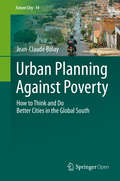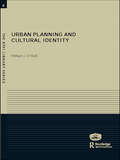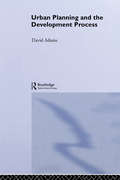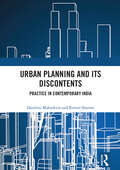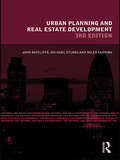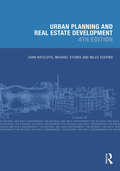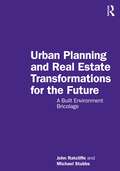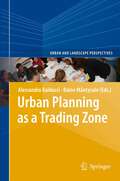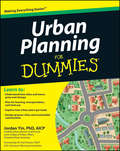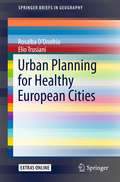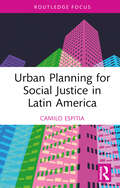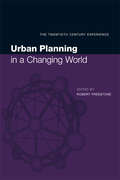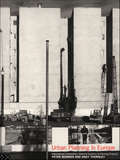- Table View
- List View
Urban Planning Against Poverty: How to Think and Do Better Cities in the Global South (Future City #14)
by Jean-Claude BolayThis open access book revisits the theoretical foundations of urban planning and the application of these concepts and methods in the context of Southern countries by examining several case studies from different regions of the world. For instance, the case of Koudougou, a medium-sized city in one of the poorest countries in the world, Burkina Faso, with a population of 115.000 inhabitants, allows us to understand concretely which and how these deficiencies are translated in an African urban context. In contrast, the case of Nueve de Julio, intermediate city of 50.000 dwellers in the pampa Argentina, addresses the new forms of spatial fragmentation and social exclusion linked with agro export and crisis of the international markets. Case studies are also included for cities in Asia and Latin America. Differences and similarities between cases allow us to foresee alternative models of urban planning better adapted to tackle poverty and find efficient ways for more inclusive cities in developing and emerging countries, interacting several dimensions linked with high rates of urbanization: territorial fragmentation; environmental contamination; social disparities and exclusion, informal economy and habitat, urban governance and democracy.
Urban Planning and Cultural Identity (RTPI Library Series)
by William NeillUrban Planning and Cultural Identity reviews the intense spatiality of conflict over identity construction in three cities where culture and place identity are not just post-modernist playthings but touch on the raw sensibilities of who people define themselves to be. Berlin as the reborn German capital has put 'coming to terms with' the Holocaust and the memory of the GDR full square at the centre of urban planning. Detroit raises questions about the impotence and complicity of planners in the face of the most extreme metropolitan spatial apartheid in the United States and where African-American identity now seems set on a separatist course. In Belfast, in the clash of Irish nationalist and Ulster unionist traditions, place can take on intense emotional meanings in relation to which planners as 'mediators of space' can seem ill equipped.The book, drawing on extensive interview sources in the case study cities, poses a question of broad relevance. Can planners fashion a role in using environmental concerns such as Local Agenda 21 as a vehicle of building a sense of common citizenship in which cultural difference can embed itself?
Urban Planning and Cultural Identity (RTPI Library Series)
by William NeillUrban Planning and Cultural Identity reviews the intense spatiality of conflict over identity construction in three cities where culture and place identity are not just post-modernist playthings but touch on the raw sensibilities of who people define themselves to be. Berlin as the reborn German capital has put 'coming to terms with' the Holocaust and the memory of the GDR full square at the centre of urban planning. Detroit raises questions about the impotence and complicity of planners in the face of the most extreme metropolitan spatial apartheid in the United States and where African-American identity now seems set on a separatist course. In Belfast, in the clash of Irish nationalist and Ulster unionist traditions, place can take on intense emotional meanings in relation to which planners as 'mediators of space' can seem ill equipped.The book, drawing on extensive interview sources in the case study cities, poses a question of broad relevance. Can planners fashion a role in using environmental concerns such as Local Agenda 21 as a vehicle of building a sense of common citizenship in which cultural difference can embed itself?
Urban Planning and Development in China and Other East Asian Countries
by Guanzeng Zhang Lan WangThis book examines urban development and its role in planning in China and other Asian cities. Starting with a substantial narrative on the history, development philosophy, and urban form of ancient Asian cities, it then identifies the characteristics of urban society and different phases of development history. It then discusses urbanization patterns in China with a focus on spatial layout of the city clusters in the Yangtze River Delta since the 20th Century. Lastly, it explores institutional design and the legal system of urban planning in China and other Asian cities. As a textbook for the “Model Course in English” for international students listed by the Ministry of Education in China, it helps international researchers and students to understand urban development and planning in Asian cities.
Urban Planning And The Development Process
by David AdamsThis text is about the very essence of urban planning in a market economy. It is concerned with people - landowners, developers, investors, politicians and ordinary members of the public - who produce change in towns and cities as they relate to each other and react to development Pressure. Whether Such Change Occurs Slowly And Is Almost Unnoticed, Or happens rapidly and is highly disruptive, a production process is creating a finished product: the built environment. This form of production, known as the land and property development process, is regulated but not controlled by the state. Urban planning is therefore best considered as one form of state intervention in the development process.; Since urban planning would have no legitimate basis without state power, it is an inherently political activity, able to alter the distribution of scarce environmental resources. Through doing so, it seeks to resolve conflicts of interest over the use and development of land. However, urban plans that appear to favour particular interests such as house-builders above others such as community groups provoke intense controversy. Development planning can thus become highly politicized, with alliances and divisions between politicians not always explained by traditional party politics.; These issues are explored with particular reference to statutory plan-making at the local level. The author draws on his extensive research into urban planning and development, making use of recent case studies and examples to illustrate key points. There are four parts. The first explores the operation of land and property markets and development processes, and examines how the state intervenes in the form of urban planning. The second part looks at the people and organizations who play a critical role in shaping the built environment and considers their relationship with the planning system. Specific attention is paid to important actors in the development process, such as landowners, developers, financial institutions, professional advisers and to the variety of agencies in the public sector that aim to promote development. This concludes with discussion of public- private partnerships and growth coalitions. The third part of the book concentrates on local development planning.
Urban Planning And The Development Process
by David AdamsThis text is about the very essence of urban planning in a market economy. It is concerned with people - landowners, developers, investors, politicians and ordinary members of the public - who produce change in towns and cities as they relate to each other and react to development Pressure. Whether Such Change Occurs Slowly And Is Almost Unnoticed, Or happens rapidly and is highly disruptive, a production process is creating a finished product: the built environment. This form of production, known as the land and property development process, is regulated but not controlled by the state. Urban planning is therefore best considered as one form of state intervention in the development process.; Since urban planning would have no legitimate basis without state power, it is an inherently political activity, able to alter the distribution of scarce environmental resources. Through doing so, it seeks to resolve conflicts of interest over the use and development of land. However, urban plans that appear to favour particular interests such as house-builders above others such as community groups provoke intense controversy. Development planning can thus become highly politicized, with alliances and divisions between politicians not always explained by traditional party politics.; These issues are explored with particular reference to statutory plan-making at the local level. The author draws on his extensive research into urban planning and development, making use of recent case studies and examples to illustrate key points. There are four parts. The first explores the operation of land and property markets and development processes, and examines how the state intervenes in the form of urban planning. The second part looks at the people and organizations who play a critical role in shaping the built environment and considers their relationship with the planning system. Specific attention is paid to important actors in the development process, such as landowners, developers, financial institutions, professional advisers and to the variety of agencies in the public sector that aim to promote development. This concludes with discussion of public- private partnerships and growth coalitions. The third part of the book concentrates on local development planning.
Urban Planning and its Discontents: Practice in Contemporary India
by Darshini Mahadevia Rutool SharmaThis book, the first of its kind, introduces various aspects of urban planning in India and contributes towards debates on changes required in the current practice. Urban planning in India means many things to city residents and is used generically to include all interventions in the cities, such as public policy design, institutional design, spatial and territorial plans, infrastructure plans, public administration, community participation, and their implementation through programmes, schemes, and projects. While urban planning is expected to meet the global development agendas of equitable and just urbanisation, climate change and sustainable development goals (SDGs), in practice it has largely remained confined to statutory spatial planning represented by ‘Master Plan’ or ‘Comprehensive Plan’. This volume delves into this world of urban planning as critical insiders to see how it works in India, analysing the city level spatial plans, the Master or Development Plans, of select cities to assess whether these are capable of addressing the global agendas and coordinate with all other plans prepared for the city. It examines whether it would work in reference to the contemporary issues, SDGs, and global agendas, and discusses strategies on how to make it work better. It also deals with each of the above stated criticisms of the practice and examines the debates, data, approaches, agendas, plans, and the future of urban planning in India. This book comes in at a time when the urban planners and policy makers have themselves begun to discuss a need to relook at urban planning practices and tools to meet the future requirements of urbanisation in India. It will be a useful reference volume for the students, scholars and practitioners alike, and be of interest to researchers and students of urban planning, architecture, public administration, civil engineering, geography, economics, and sociology. It will also be useful for policy makers and professionals working in the areas of town and country planning.
Urban Planning and its Discontents: Practice in Contemporary India
by Darshini Mahadevia Rutool SharmaThis book, the first of its kind, introduces various aspects of urban planning in India and contributes towards debates on changes required in the current practice. Urban planning in India means many things to city residents and is used generically to include all interventions in the cities, such as public policy design, institutional design, spatial and territorial plans, infrastructure plans, public administration, community participation, and their implementation through programmes, schemes, and projects. While urban planning is expected to meet the global development agendas of equitable and just urbanisation, climate change and sustainable development goals (SDGs), in practice it has largely remained confined to statutory spatial planning represented by ‘Master Plan’ or ‘Comprehensive Plan’. This volume delves into this world of urban planning as critical insiders to see how it works in India, analysing the city level spatial plans, the Master or Development Plans, of select cities to assess whether these are capable of addressing the global agendas and coordinate with all other plans prepared for the city. It examines whether it would work in reference to the contemporary issues, SDGs, and global agendas, and discusses strategies on how to make it work better. It also deals with each of the above stated criticisms of the practice and examines the debates, data, approaches, agendas, plans, and the future of urban planning in India. This book comes in at a time when the urban planners and policy makers have themselves begun to discuss a need to relook at urban planning practices and tools to meet the future requirements of urbanisation in India. It will be a useful reference volume for the students, scholars and practitioners alike, and be of interest to researchers and students of urban planning, architecture, public administration, civil engineering, geography, economics, and sociology. It will also be useful for policy makers and professionals working in the areas of town and country planning.
Urban Planning and Real Estate Development (Natural and Built Environment Series)
by John Ratcliffe Michael Stubbs Miles KeepingThe twin processes of planning and property development are inextricably linked – it’s not possible to carry out a development strategy without an understanding of the planning process, and equally planners need to know how real estate developers do their job. This third edition of Urban Planning and Real Estate Development guides students through the procedural and practical aspects of developing land from the point of view of both planner and developer. The planning system is explained, from the increasing emphasis on spatial planning at a regional level down to the detailed perspective of the development control process and the specialist requirements of historic buildings and conservation areas. At the same time the authors explain the entire development process from inception through appraisal, valuation and financing to completion and disposal. This is an invaluable textbook for real estate and planning students, and helps to meet the requirements of the RICS and RTPI Assessment of Professional Competence.
Urban Planning and Real Estate Development (Natural and Built Environment Series)
by John Ratcliffe Michael Stubbs Miles KeepingThe twin processes of planning and property development are inextricably linked – it’s not possible to carry out a development strategy without an understanding of the planning process, and equally planners need to know how real estate developers do their job. This third edition of Urban Planning and Real Estate Development guides students through the procedural and practical aspects of developing land from the point of view of both planner and developer. The planning system is explained, from the increasing emphasis on spatial planning at a regional level down to the detailed perspective of the development control process and the specialist requirements of historic buildings and conservation areas. At the same time the authors explain the entire development process from inception through appraisal, valuation and financing to completion and disposal. This is an invaluable textbook for real estate and planning students, and helps to meet the requirements of the RICS and RTPI Assessment of Professional Competence.
Urban Planning and Real Estate Development (Natural and Built Environment Series)
by John Ratcliffe Michael Stubbs Miles KeepingThis fourth edition of Urban Planning and Real Estate Development guides readers through the procedural and practical aspects of developing land from the point of view of both planner and developer. The twin processes of planning and property development are inextricably linked – it is not possible to carry out a development strategy without an understanding of the planning process, and, equally, planners need to know how real estate developers do their job. The planning system is explained, from the increasing emphasis on spatial planning at a national, local, and neighbourhood level down to the detailed perspective of the development management process and the specialist requirements of historic buildings and conservation areas. At the same time, the authors explain the entire development process from inception, through appraisal, valuation, and financing, to completion. Sustainability and corporate social responsibility and their impact on planning and development are covered in detail, and the future consequences of the COVID-19 pandemic are explored in new opening and closing chapters setting the text in a global context. Written by a team of authors with many years of academic, professional, and research experience, and illustrated throughout with practical case studies and follow-up resources, this book is an invaluable textbook for real estate and planning students and helps to meet the requirements of the RICS and RTPI Assessment of Professional Competence.
Urban Planning and Real Estate Development (Natural and Built Environment Series)
by John Ratcliffe Michael Stubbs Miles KeepingThis fourth edition of Urban Planning and Real Estate Development guides readers through the procedural and practical aspects of developing land from the point of view of both planner and developer. The twin processes of planning and property development are inextricably linked – it is not possible to carry out a development strategy without an understanding of the planning process, and, equally, planners need to know how real estate developers do their job. The planning system is explained, from the increasing emphasis on spatial planning at a national, local, and neighbourhood level down to the detailed perspective of the development management process and the specialist requirements of historic buildings and conservation areas. At the same time, the authors explain the entire development process from inception, through appraisal, valuation, and financing, to completion. Sustainability and corporate social responsibility and their impact on planning and development are covered in detail, and the future consequences of the COVID-19 pandemic are explored in new opening and closing chapters setting the text in a global context. Written by a team of authors with many years of academic, professional, and research experience, and illustrated throughout with practical case studies and follow-up resources, this book is an invaluable textbook for real estate and planning students and helps to meet the requirements of the RICS and RTPI Assessment of Professional Competence.
Urban Planning and Real Estate Transformations for the Future: A Built Environment Bricolage
by John Ratcliffe Michael StubbsThis book presents fresh ways of thinking about the future for all those involved in conceiving, planning, designing, funding, constructing, occupying and managing the built environment, to face the challenges, and grasp the opportunities, that lie ahead over the next few decades. Four major themes form the basis of the volume:(1) Future Awareness and a New Sense of Place.(2) Global Governance and Anticipatory Leadership. (3) Innovation, Reform and Exemplars. (4) Urban Planning and Real Estate Transformations. Within these structural themes are a diverse range of 'Discourses' addressing many of the big questions and driving forces that face us, together with a proposed methodology (Strategic Foresight) and an array of practical illustrations viewing what can be done today – whether by organisations, individuals, cities or communities – to positively shape a preferred future and manipulate us towards achieving it. It will be important reading for students, practitioners, agencies and corporations across the built environment, especially in the fields of urban planning, real estate development, architecture, civil engineering and construction.
Urban Planning and Real Estate Transformations for the Future: A Built Environment Bricolage
by John Ratcliffe Michael StubbsThis book presents fresh ways of thinking about the future for all those involved in conceiving, planning, designing, funding, constructing, occupying and managing the built environment, to face the challenges, and grasp the opportunities, that lie ahead over the next few decades. Four major themes form the basis of the volume:(1) Future Awareness and a New Sense of Place.(2) Global Governance and Anticipatory Leadership. (3) Innovation, Reform and Exemplars. (4) Urban Planning and Real Estate Transformations. Within these structural themes are a diverse range of 'Discourses' addressing many of the big questions and driving forces that face us, together with a proposed methodology (Strategic Foresight) and an array of practical illustrations viewing what can be done today – whether by organisations, individuals, cities or communities – to positively shape a preferred future and manipulate us towards achieving it. It will be important reading for students, practitioners, agencies and corporations across the built environment, especially in the fields of urban planning, real estate development, architecture, civil engineering and construction.
Urban Planning as a Trading Zone (Urban and Landscape Perspectives #13)
by Alessandro Balducci and Raine Mäntysalo'Trading zone' is a concept introduced by Peter Galison in his social scientific research on how scientists representing different sub-cultures and paradigms have been able to coordinate their interaction locally. In this book, Italian and Finnish planning researchers extend the use of the concept to different contexts of urban planning and management, where there is a need for new ideas and tools in managing the interaction of different stakeholders. The trading zone concept is approached as a tool in organizing local platforms and support systems for planning participation, knowledge production, decision making and local conflict management. In relation to the former theses of communicative planning theory that stress the ideals of consensus, mutual understanding and universal reason, the 'trading zone approach', outlined in this book, offers a different perspective. It focuses on the potentiality to coordinate locally the interaction of different stakeholders without requiring the deeper sharing of understandings, values and motives between them. Galison’s commentary comes in the form of the book’s final chapter.
Urban Planning for Climate Change (Routledge Advances in Climate Change Research)
by Barbara NormanThis book tackles the future challenges and opportunities for planning our cities and towns in a changing climate and recommends key actions for more resilient urban futures. Urban Planning for Climate Change focusses on how urban planning is fundamental to action on climate change. In doing so it particularly looks at current practice and opportunities for innovation and capacity building in the future - carbon neutral development, building back better and creating more resilient urban settlements around the world. The complex challenge of possible urban resettlement from the impact of climate change is covered as a special issue bringing a focus on adaptation, working with nature and delivering real action on climate change with local communities. Norman recommends ten essential actions for urban planning for climate change along with some suggestions to inspire the next generations to embrace these opportunities with creativity and innovation. Featuring key messages and implications for practice in each chapter, this book will be of great interest to students, scholars, practitioners and communities involved in planning more climate resilient urban and regional futures.
Urban Planning for Climate Change (Routledge Advances in Climate Change Research)
by Barbara NormanThis book tackles the future challenges and opportunities for planning our cities and towns in a changing climate and recommends key actions for more resilient urban futures. Urban Planning for Climate Change focusses on how urban planning is fundamental to action on climate change. In doing so it particularly looks at current practice and opportunities for innovation and capacity building in the future - carbon neutral development, building back better and creating more resilient urban settlements around the world. The complex challenge of possible urban resettlement from the impact of climate change is covered as a special issue bringing a focus on adaptation, working with nature and delivering real action on climate change with local communities. Norman recommends ten essential actions for urban planning for climate change along with some suggestions to inspire the next generations to embrace these opportunities with creativity and innovation. Featuring key messages and implications for practice in each chapter, this book will be of great interest to students, scholars, practitioners and communities involved in planning more climate resilient urban and regional futures.
Urban Planning For Dummies
by Jordan YinHow to create the world's new urban future With the majority of the world's population shifting to urban centres, urban planning—the practice of land-use and transportation planning to help shape cities structurally, economically, and socially—has become an increasingly vital profession. In Urban Planning For Dummies, readers will get a practical overview of this fascinating field, including studying community demographics, determining the best uses for land, planning economic and transportation development, and implementing plans. Following an introductory course on urban planning, this book is key reading for any urban planning student or anyone involved in urban development. With new studies conclusively demonstrating the dramatic impact of urban design on public psychological and physical health, the impact of the urban planner on a community is immense. And with a wide range of positions for urban planners in the public, nonprofit, and private sectors—including law firms, utility companies, and real estate development firms—having a fundamental understanding of urban planning is key to anyone even considering entry into this field. This book provides a useful introduction and lays the groundwork for serious study. Helps readers understand the essentials of this complex profession Written by a certified practicing urban planner, with extensive practical and community-outreach experience For anyone interested in being in the vanguard of building, designing, and shaping tomorrow's sustainable city, Urban Planning For Dummies offers an informative, entirely accessible introduction on learning how.
Urban Planning For Dummies
by Jordan YinHow to create the world's new urban future With the majority of the world's population shifting to urban centres, urban planning—the practice of land-use and transportation planning to help shape cities structurally, economically, and socially—has become an increasingly vital profession. In Urban Planning For Dummies, readers will get a practical overview of this fascinating field, including studying community demographics, determining the best uses for land, planning economic and transportation development, and implementing plans. Following an introductory course on urban planning, this book is key reading for any urban planning student or anyone involved in urban development. With new studies conclusively demonstrating the dramatic impact of urban design on public psychological and physical health, the impact of the urban planner on a community is immense. And with a wide range of positions for urban planners in the public, nonprofit, and private sectors—including law firms, utility companies, and real estate development firms—having a fundamental understanding of urban planning is key to anyone even considering entry into this field. This book provides a useful introduction and lays the groundwork for serious study. Helps readers understand the essentials of this complex profession Written by a certified practicing urban planner, with extensive practical and community-outreach experience For anyone interested in being in the vanguard of building, designing, and shaping tomorrow's sustainable city, Urban Planning For Dummies offers an informative, entirely accessible introduction on learning how.
Urban Planning for Healthy European Cities (SpringerBriefs in Geography)
by Rosalba D'Onofrio Elio TrusianiThis book investigates different aspects of the relationship between “healthy cities” and “urban planning”, examining various best practices in Europe. It uses the above as a starting point and investigates different aspects of healthy cities, examining various best practices in Europe. Capitalizing on ongoing trials, the chapters identify the policies that underlie plans and projects that have caused positive changes in local communities in terms of the quality of life and safety of inhabitants. From these best practices, the book deduces criteria and guidelines for planning healthy and safe cities.
Urban Planning for Social Justice in Latin America
by Camilo EspitiaUrban Planning for Social Justice in Latin America explores how urban planning can be used as a tool for social equity. The book examines several Latin American cities, each with specific challenges, and explores how they have gradually overcome these difficulties through policies, planning, and design, and with private/public sector coordination. The cases include: The built environment and social mobility in Bogotá; Mexico City and its difficulties with water scarcity; Addressing air quality and environmental justice in Lima; Santiago de Chile’s energy consumption and carbon footprint; Buenos Aires and the issue of urban agriculture and food security; Connectivity as a social transformation device in Medellín. The book goes beyond simply identifying the challenges and explains some of the practical day-to-day planning efforts, including interviews with staff from those municipalities, illustrations, and strategies that have been successful. As a result, this book will be helpful to planners in the region, as well as outside Latin America, because it demonstrates how fruitful results can be achieved in areas typically perceived as underdeveloped. Although based on research and data, this book offers a positive perspective on the possibilities rather than the limitations, hoping to inspire new generations of planners to pursue careers in search of social change.
Urban Planning for Social Justice in Latin America
by Camilo EspitiaUrban Planning for Social Justice in Latin America explores how urban planning can be used as a tool for social equity. The book examines several Latin American cities, each with specific challenges, and explores how they have gradually overcome these difficulties through policies, planning, and design, and with private/public sector coordination. The cases include: The built environment and social mobility in Bogotá; Mexico City and its difficulties with water scarcity; Addressing air quality and environmental justice in Lima; Santiago de Chile’s energy consumption and carbon footprint; Buenos Aires and the issue of urban agriculture and food security; Connectivity as a social transformation device in Medellín. The book goes beyond simply identifying the challenges and explains some of the practical day-to-day planning efforts, including interviews with staff from those municipalities, illustrations, and strategies that have been successful. As a result, this book will be helpful to planners in the region, as well as outside Latin America, because it demonstrates how fruitful results can be achieved in areas typically perceived as underdeveloped. Although based on research and data, this book offers a positive perspective on the possibilities rather than the limitations, hoping to inspire new generations of planners to pursue careers in search of social change.
Urban Planning in a Changing World: The Twentieth Century Experience
by FreestoneUrban planning in today's world is inextricably linked to the processes of mass urbanization and modernization which have transformed our lives over the last hundred years. Written by leading experts and commentators from around the world, this collection of original essays will form an unprecedented critical survey of the state of urban planning a
Urban Planning in a Changing World: The Twentieth Century Experience (Studies In History, Planning, And The Environment)
by FreestoneUrban planning in today's world is inextricably linked to the processes of mass urbanization and modernization which have transformed our lives over the last hundred years. Written by leading experts and commentators from around the world, this collection of original essays will form an unprecedented critical survey of the state of urban planning a
Urban Planning in Europe: International Competition, National Systems and Planning Projects
by Peter Newman Andy ThornleyUrban planning is undergoing a period of transformation across Europe, with a major trend towards increased urban competition, national deregulation and greater private sector influence.Urban Planning in Europe is the first comprehensive analysis of the influence of countries is developed, presenting the similarities and differences of each country's national planning system. The authors use detailed case studies to explore planning policies in a range of European cities, and discuss the social and environmental objectives that influence today's urban planner.Urban Planning in Europe is an essential guide to contemporary European planning projects and highlighting opportunities for innovation which contain vital lessons for the future of urban decision making.
